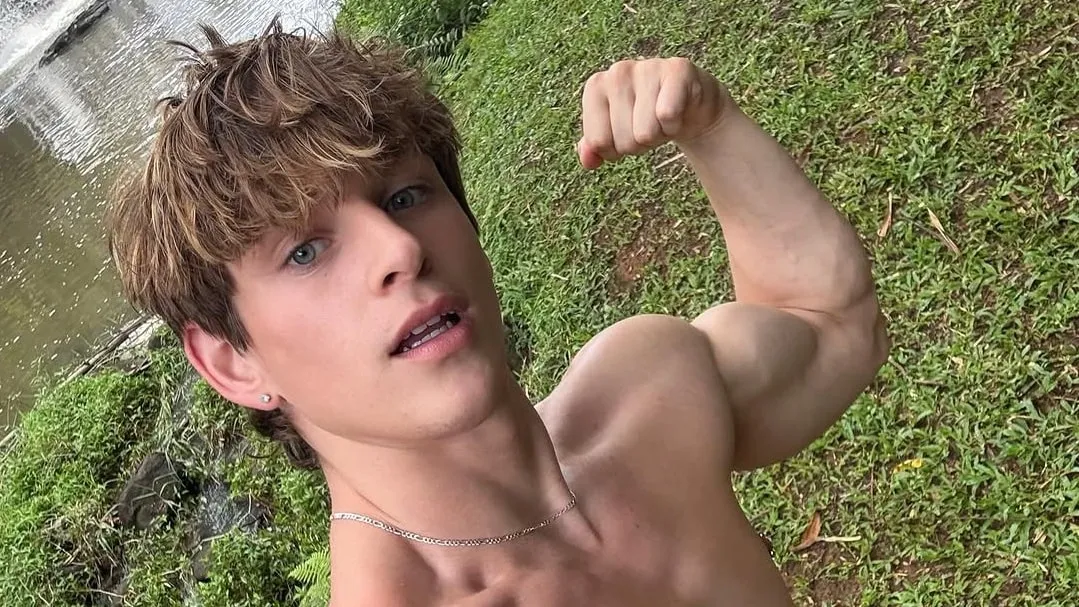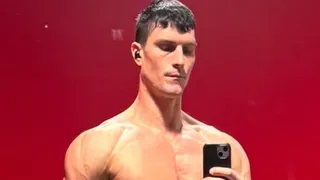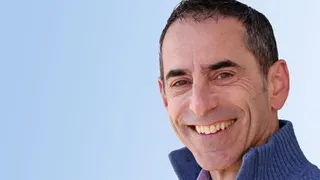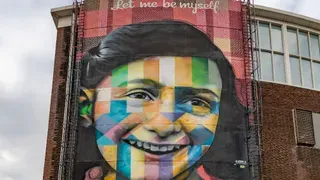October 23, 2020
Talking with the Authors of 'LOVING' – Photo Book Celebrating a Century of Gay Couples
Kilian Melloy READ TIME: 21 MIN.
Longtime couple Hugh Nini and Neil Treadwell didn't know two decades ago, when they acquired their first antique photo of two men depicted in a loving pose, that they had taken the first step in a journey that would lead them to collect thousands of such vintage and antique photos from all around the world, create a name to characterize the nature of the images in that collection – they call this specific form "vernacular photography" – or that that one day they would collect the images into a book that would sell out its first printing on its first day of release.
Yet, here we are; and the book in question, titled "LOVING - A Photographic History of Men in Love 1850s - 1950s" stands at the intersection of art and history, a validation and celebration of romantic love between men that echoes, and remains recognizable, across the centuries.
Though Nini and Treadwell's collection now exceeds 3,000 images, they were able to present only a few hundred in this volume. But the carefully curated selection offers a deep and broad cross-section of male coupledom, featuring photos from different nations and historical periods. What remains a constant – as Nini and Treadwell explain in the essay that prefaces the book – is a "look in their eyes," which, even when the poses don't tell a story of physical and emotional bonding, clearly communicates the intensity of the connection between the men depicted. The collectors used what they called the "50/50 test" when determining which photos to collect: They had to be at least 50% convinced that the men in the photographs weren't just close friends or relatives, or else merely joking around, but that the emotional connection was both romantic and palpable.
And they are, across an astonished cross-section of historical periods, social classes, and occupations. Sailors, soldiers, farmers; men shown in natural settings, surrounded by friends and family, or photographed on board the naval ships on which they serve; men spooning and asleep under the covers, or lounging on their bed with a newspaper. Above all, men in deep communion with each other, clearly in love and devoted. The images here make it plain to see that love is not only universal, but also timeless. Love is love – and always was.
EDGE had the pleasure of chatting with Hugh Nini and Neil Treadwell about "LOVING."
EDGE: You both work in the art world. Do you see this collection of images you've assembled as art as well as historical documentation?
Neal Treadwell: I'll answer that, because I do – we both do. Now, on our cell phones or computers, we can crop, we can do anything to a photograph. But back then they actually had to look and take a photograph of what they saw with their eye, and that's what you developed. You never knew what you had until you developed your film. And so, to me, on the art side I look at a photograph's aesthetic purpose and what it looks like and how the subjects are positioned, and a lot of times it's natural. Most of our photographs are; they're natural. There are some that are done in studios, but that just brings out a natural beauty that's hard to catch.
EDGE: Like you say, before digital photography and cell phone cameras, the process of creating a photo used to be something special. Now we have people posting millions of selfies every day. Have we lost something with that transition?
Hugh Nini: I think we're lost something! When you think of taking a photograph 170 years ago, that was a lifetime event. Today it's what you do every five minutes. That has really diminished the importance of it, and the value of it, compared to the time period this collection deals with. I think one of the things that you sort of alluded to – that people respond to when they see this collection – is they see that these photos were special during their time and they're equally special, if not more, for having survived as long as 170 years to convey the message that was in them then to us today, now. You don't get that from taking a picture of what you're eating every two seconds, or whatever. It's a whole different thing. So people are coming into this book and they're discovering something that we've lost in our current society in that form.
Neal Treadwell: You've lost the anticipation and excitement of what could be, or what you're going to see. And now everything's disposable on the phone.
EDGE: With photos being the really special thing they were back then, it's even more remarkable that there would be these male couples who would commit their affection to film in the way that they did.
Hugh Nini: It's extraordinary, the risks that they were taking. In a lot of cases, we suspect that these photographs were taken by the couples themselves because being able to take your own photograph dates back to 1903, I believe – or earlier. Just the way that some of the photographs are set up, it looks like they might have done them themselves. That being said, there are plenty of photographs where they're with friends or family, and/or you can see the photographer's shadow in their picture. So, just like today, they had friends and allies. It just has to be that there were photographers that were sympathetic and / or gay themselves, that they could trust when they brought their film, or whatever the format was, to them for developing.
Neal Treadwell: If you look at the tintypes that we have – that's a photograph on the metal – that's a one-shot process and there's no negative to it, so once it was photographed and put on the metal it was handed to the customer within thirty minutes, and they walked away with it. They could do something really fast before the photograph was taken, and then it was captured, and it was theirs, and there was only one in the world.
EDGE: Making it even more rare and fantastic that these images survived.
Hugh Nini: It was like the Polaroid Instamatic of its day.
EDGE: As you point out, you see men with their families and with their friends, or you see them in kind of public space – for instance, there's a picture of two men standing on a mockup of a train, with a sign reading "Honeymoon Express," or there are lots of photos of couples who are sitting together on crescent moons, and you know these were commercial spaces. Was there maybe a winking acceptance of gay relationships? Or maybe people then didn't really see it because it flew under their radar?
Hugh Nini: You're referring to the "paper moon" photos, and that's a big category in our collection. We didn't realize that it was a thing when we got the first one, and then the second the third and the fourth, and I think we have fifty or something like that – it's quite a few. Those all tend to fall into an era that started in the 1890s and went up through 1920, where these couples – paper moon or otherwise – seem to be living in a more comfortable, tolerant world than the one before or the one after. Those three decades, you just see a joy and a comfort... a freedom that you don't see before or after that.
EDGE: And maybe a little like what we see today, at least in certain places, where there's a casualness or an acceptance that's assumed.
Hugh Nini: Yes, it seems that way. It wasn't a blanket acceptance, but there did seem to be spaces where they could go and be, with their families, even. We have examples of that, where there were acceptance and understanding.
EDGE: You say in your book that you acquired a photo of two men taken in the 1920s and you thought this image was unique. But then you began to find more and more, and now you've got more than 2,800 of these images.
Hugh Nini: More than 3,000 now.
EDGE: More than 3,000? Wow! So, has the experience of collecting these photos, seeing these photos, curating them for the book, changed your impression of the past; changed your impression of men, or of love?
Neal Treadwell: When we started collecting, we thought [that first image] was the only one; we thought it was something special, a couple, together.
Hugh Nini: People like us during that time [in history].
Neal Treadwell: I mean, we have friends who have been together as long as we have, but we thought it was something new. We found this photograph and thought, "Oh wow, someone actually captured the love that they had for each other in a photograph." And that one sat on our desk for probably a couple of months before we found a second one. And as we collected more and more, we realized that we're nothing new. [Male couples have] been around since even before photography, we're sure. We found a painting in the Louvre, too – that's another story. I digress.
It's just amazing, the photographs and the love that you see. And when we share them with people, they say, "Oh my gosh, that's love. I see the love in their eyes." And these are straight friends and gay friends, and family...
Hugh Nini: Conservative, progressive, old, young.
Neil Treadwell: They get past anything else other than that they see love in the two people's eyes.
Hugh Nini: And in answer to the question about us personally, there has been an evolution in our understanding of us even though we've been together for a really long time.
We've started to think and talk differently about this subject. We don't call these couples "homosexual couples" or "gay couples." We don't have those pictures. What we have are pictures of two people who are in love with each other, and we call them same-gender couples. We don't say same-sex couples, because sex is private; gender is right here. We refer to them as "loving couples." We assume, like everybody else does looking at the photographs, that they probably had a physical, intimate life as well – we hope so, anyway – but what we have pictures of are them being in love with each other.
The reason we feel that's really important is because love – it's clich� to say it, but it's absolutely true – love is universal. The love that we have for each other is no different from the love that our parents had for each other, or our neighbors, or whoever, whatever male and female couple we're talking about. There's not a different love for us than them; it's the same. The book puts the conversation in this area where everybody experiences the same [thing] we can all relate to, and that's what we really tried hard to put across.
EDGE In the book's introduction you talk about how the people in this collection of photographs did not have a way to share their own narrative, except through these photos that we look at now. Was giving these people from the past the chance to tell their own narrative through these images a primary motivation for assembling this book?
Hugh Nini: That's one of the things that we started to understand as we got into the process of publishing the book and writing this essay. We didn't even realize we had a collection until about ten years ago. We were just doing this in our sleep, really. But it became intentional. We started to see all of these photographs and we started to look at each other and say, "We can't be the only two people looking at these. These are important. They need to be seen by other people."
In the process of doing the book, one of the things [we came to realize] is that these couples have these really powerful feelings for one another and dared to take a photograph of them – sometimes kissing, sometimes in bed together – clothed, but in a bed, nonetheless. And they dared to do that, and the only way it could survive was that it be hidden and kept safe. And that's how it is with us today. So, they could not narrate their lives. It was left to clergy, police, community, churches to talk about them and define who they were, which was never accurate. And so, these photographs are a way that they can now give voice to what their lives were in actuality. This part was never shared with anybody. Now it's being shared. Now they talk about their lives Now they get to say, "This is who we were, and in this moment we loved each other very much."
EDGE: What's also striking is how many of the photos show us men in uniform.
Neal Treadwell: Probably 20%, if not more, of our collection is [of] military [men], and – knock on wood – the second volume will be "LOVING - Men in the Military." We have photos as early as the Civil War, going all the way through World War I, World War II – not just in the U.S., but around the world – of military men.
Hugh Nini: It was surprising even to us that there were so many military photos. But if you think about it, during World War I, World War II, the Civil War, these men were told "You have to go fight," and everybody had to go. That meant straight men went, and gay men went. All these gay men were put together in the same place, and so it's logical that they were able to find one another, form relationships, and sometimes they were long-lasting and sometimes they weren't. That accounts for the very logical sociological reason for why there are so many military photos.
Neal Treadwell: We just had someone reach out to us through email two days ago who said, "I am so happy for this book – I cannot wait to get it. I met my first boyfriend in Vietnam." It was so sweet. He said, "I've been with my husband now for 20 years. I can't wait to share this – it just brings back so many memories." That's one thing about the book: We know it's going to bring more stories like that to us, and it's just so touching.
EDGE: You share a poignant story in your introduction about some of the photos in your collection that belonged to a man named John W. Moore, who held on to a shoebox full of photos of himself and his lover, Dariel, with whom he had served in World War II. And not just photos – he and his partner had rings. Moore's nephew ended up with the photos. Did you acquire them all at once from the nephew? Or did you have to track them all down over time?
Neal Treadwell: We got them all from him, but not all at once. It was maybe a six-month-long process. We formed a very sentimental bond with this man. He loved his uncle very much, and his uncle loved him very much. They lived next door to each other – we lay this out in the essay – and the uncle was confined to a wheelchair because he suffered from muscular dystrophy. Near the end of his life, he gave the nephew this shoebox and this ring, and he said to the nephew, "Please keep these safe for me."
These photographs that he handed to his nephew would have been, at that point, almost 50 years old, He treasured them. The nephew never really paid any attention to what was in the box until a long time later. I think he gave the nephew the ring separately, but the nephew wears the ring to this day.
[Moore] was a gay man in a small Texas town, and I can just imagine that he would take the shoebox out when he needed to, to remember fond times and this relationship that he had, and that sustained him throughout all of his adult life. At the very end, he said, "I want these to live past me." And so that's how the nephew got them, and we got them, and we got them in dribs and drabs. The first few we collected, and we put our 50/50 parameters for collecting to the test, because the first five or six photographs of the two of them were like us [right now], just sort of sitting here next to each other. Nothing spectacular. But there's this look in their eyes that made us go, "Hmmm, I think there's something going on here." Because they're not expensive, we went ahead and took the risk and collected them. And then the crown jewel showed up, which you see in the book, the one of the two of them in the snow, embracing. That's proof positive that we were correct in our early assessment of the two of them.
EDGE: You mention that you see a lot of identical poses from men in different time periods and different places around the world. It's something that rises from them innately. What does this tell you about the nature of their love – and of human love, human connection?
Hugh Nini: Neal is the one that saw this before anybody.
Neal Treadwell: We had just been packing them in all the albums. We decided that we needed to give them a little more focus and the respect that they deserve.
Hugh Nini: A home.
Neal Treadwell: A home. And so started pulling them out, because we had just crammed and kept saying, "Oh, here's another one, let's put this on this page because there's a little bit of room in the corner." So we pulled them all out and I started looking at them, like...
Hugh Nini That's not exactly what happened. I gave you a big pile of photos...
Neal Treadwell: Okay.
Hugh Nini: And I said, "Could you figure out how to arrange these in the next album," and he was over there just moving them around...
Neal Treadwell: I was at the table behind us, and I was separating them and I went, "Oh my god." It just started showing the patterns, whether it's [one man with his arm] over the shoulder [of his partner], or finger holding [demonstrating with interlocked index fingers], or double handholding, all kinds of things.
Hugh Nini He didn't say anything; I walked over and I looked down at what he'd done and I went, "Oh my gosh, that's insane!"
Neil Treadwell: There would be photographs from 1860 all the way up to 1920, and it's the same position. There's a pose, and there's a relaxed view of a photograph. If you look at a lot of photographs of heterosexual couples back then, they were always so stern, and there was always something about not showing a lot of affection. But these photographs, they pose like this... [Mimes resting a head on a partner's shoulder] But it's not just this comfort where you're relaxed with someone. And that's what you saw in these photographs. It was a natural type of...
Hugh Nini: They arrived at these really similar and intricate poses – hand-holding, leg-crossing, whatever it is, there are maybe 50 categories. They did it all over the world, and they did it all across a 170 year period.
EDGE: In addition to those really sweet, poignant poses – arms around the shoulders, hand holding – there's a couple that show some real spark and levity, like the guys who have their fingers pressed to their lips in a very cute pose.
Hugh Nini: Yes, there's some levity. The photo you're referencing, there are two versions of that, two that are identical and were made at the same time. One we got here in the United States, and the other we got in Australia.
EDGE: So these photos have been circulating all over the place for all this time.
Hugh Nini: We know that it originated in the U.S., but somehow one of them made it to Australia. And then back to the U.S. [when we acquired it].
Neil Treadwell: They were postcards. So, you would go in and have your photograph taken, and it was printed off on a hard card. You could get one, or you could get, I guess, ten. People would get them and send them to someone special. The one that we found in Australia was sent within the United States from one person to another, but somehow that photograph then traveled all the way to Australia, and that's where we found it at an auction and brought it back to be with its partner.
EDGEIt's remarkable that there is a market for photos that belonged to people centuries ago – people who aren't part of your family, people you wouldn't know who they are, and don't know their stories.
Hugh Nini: I think it's what you started out with in this interview: I think people are reaching back in photography for something that's missing today. Obviously, our focus is male couples who are in love with each other, but other people are finding some kind of comfort or reassurance in, like you said, photos from the past that are maybe of kids playing, or a husband and wife dancing, or –
Neil Treadwell: Or still life.
EDGE: I have to say, the last photo in the book... that couple's really in a passionate kiss! You didn't need your 50/50 rule for that, it's 110% for sure they're in love.
Neil Treadwell: No – that was a slam-dunk!
EDGE: With all of these amazing photos and a limited amount of space, what was the criteria for deciding what to include in this book?
Neil Treadwell: It was really tough. We broke it down to 600, and then we started paring down from there. We had other people looking with us, but in the end, it was our decision on which ones made it to the book. We did pull back a little bit on the military [images] just because there were so many.
Hugh Nini: Because there might be a second volume. But we had two designers that worked on the book out of Montreal, Jean Doyenne and Renee Clement, and we gave them our selection, we cut it down from there, they did a couple of different versions of the book, and then we got to have our input about that. It was a collaborative process all the way to the end. Some of it was extremely difficult because there are some amazing photos that are not in the book. Maybe there'll be a Volume 3? I don't know.
EDGE: Did you find there was a need to digitally repair or pull out details or upgrade any of the photos, or are we seeing them as they exist now, in real life?
Hugh Nini: The way we imagined this book from the very beginning was, we were going to present the photographs exactly as they were: Show all of the bruises and scratches and dings and damage and tears and whatever, and photograph it as a full artifact. At the very last minute, our publisher found a color separator who was using a lens that's only used by four other people in the world – it's a lens from a spy satellite. He used it to make the images.
Neil Treadwell: He's an archivist. He actually takes old photographs from all over and preserves them through digital means so that they are here for eternity.
Hugh Nini: So our publisher found this man in Brussels, Belgium... and right before we got to Milan in February, [our publisher] drove up to Brussels and met this guy, and they talked about it. He came down and met us as we arrived in Milan, and we talked about how this was going to go, and he explained how he had a different idea. What we ended up doing was completely an about-face from what we had talked about from in the beginning. It was an absolute stroke of genius.
So, what has been done is, they cut down the photographs to only the message – the message of the love that's expressed in the photograph. So you're not seeing parts of the photograph, and we didn't imagine that in the beginning, but it's brilliant that they did it. He also repaired some of the images where there was some damage or discoloration or something that interrupted the message.
We fully plan and hope that the actual photos will go into a museum, in an exhibition, and in that case, people will be seeing them in their natural state, where in some cases they're pristine and in some other cases they needed some work. We know what the originals look like, and when we're looking at this page and this photo, we know that something that would have really distracted from the message of the photo has now been fixed. We say that he restored them back to their youth, when they were taken and when the couple held these photographs in their hands.
Neil Treadwell: It's what they actually had.
Hugh Nini: It's brilliant!
Neil Treadwell: Because if you think about the life of the photograph, some of them would have been folded up... you can see the creases, they were folded up and carried in a wallet or somewhere so no one else could see, and they would pull it out and look at it whenever they wanted to remember. We do have some [photographs] that are pristine, and they may have been hidden in a drawer somewhere, and they were well taken care of. We don't know what the journey is of the photographs, and that is something we can only speculate on. It's part of the history and the love.
EDGE: We kind of have to take these photos at face value, in terms of their provenance, but as you say the message is so much deeper.
Hugh Nini: Yeah. The message is the romantic love that, hopefully, people get to experience in their lifetimes. You know, we've traveled a long journey together, and we didn't always find great support for our relationship from friends and family, and that was a disappointment. There was something in the air for a long time that questioned whether loving somebody, being loved... whether that was just a movie thing, or something that got written about in a novel, but in reality didn't really exist, and so we should settle for this thing over here that's a little bit less, but it's easier to get to. We got that a lot. We were always swimming upstream in that waterfall.
We think this book says this is a real thing. It was real in these people's lives; we know it's real in our lives. What we have in common is we all feel the same way towards our partners as the others [do]. We hope that this book will give people confidence that this is something that's real, and something worth finding and keeping if you find it, and working hard for it if you need to.
Neil Treadwell: Something that we've found that's very interesting [is] the fact that so many straight people have fallen in love with [the book] and are buying it. One of the first people we spoke to about making a book said to us, "What do you think about the young kids? Have you shown your idea to any younger people?" And through Instagram and out social media, we have reached so many young couples – gay couples, early 20s, just getting married or just having their first boyfriend, and they are saying, "Oh my gosh, this book is so interesting!" They're sending notes, saying, "This is amazing! We love it! Where can we get it?" They find it touching. I find it very moving that [interest] exists, because too many of them live on this thing [holding up his smart phone], and now they're actually experiencing a new medium.
"LOVING - A Photographic History of Men in Love 1850 - 1950" is available now.
Kilian Melloy serves as EDGE Media Network's Associate Arts Editor and Staff Contributor. His professional memberships include the National Lesbian & Gay Journalists Association, the Boston Online Film Critics Association, The Gay and Lesbian Entertainment Critics Association, and the Boston Theater Critics Association's Elliot Norton Awards Committee.







